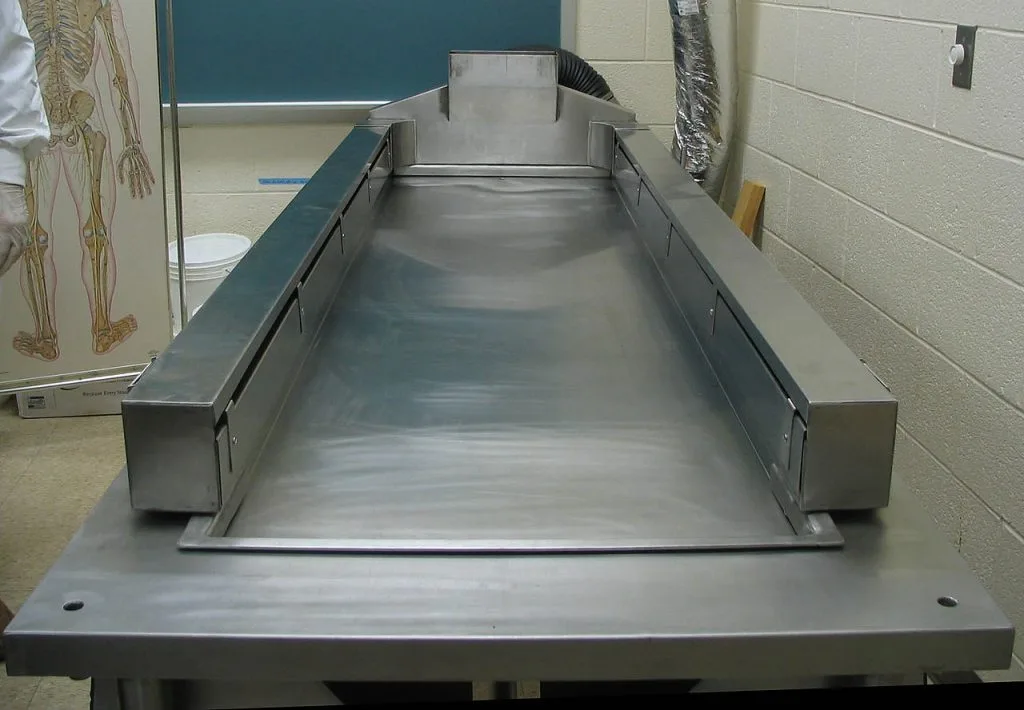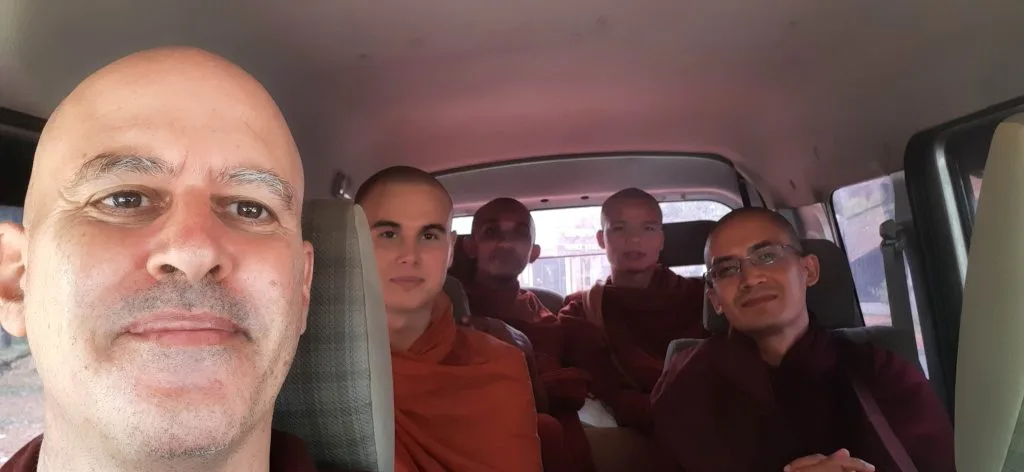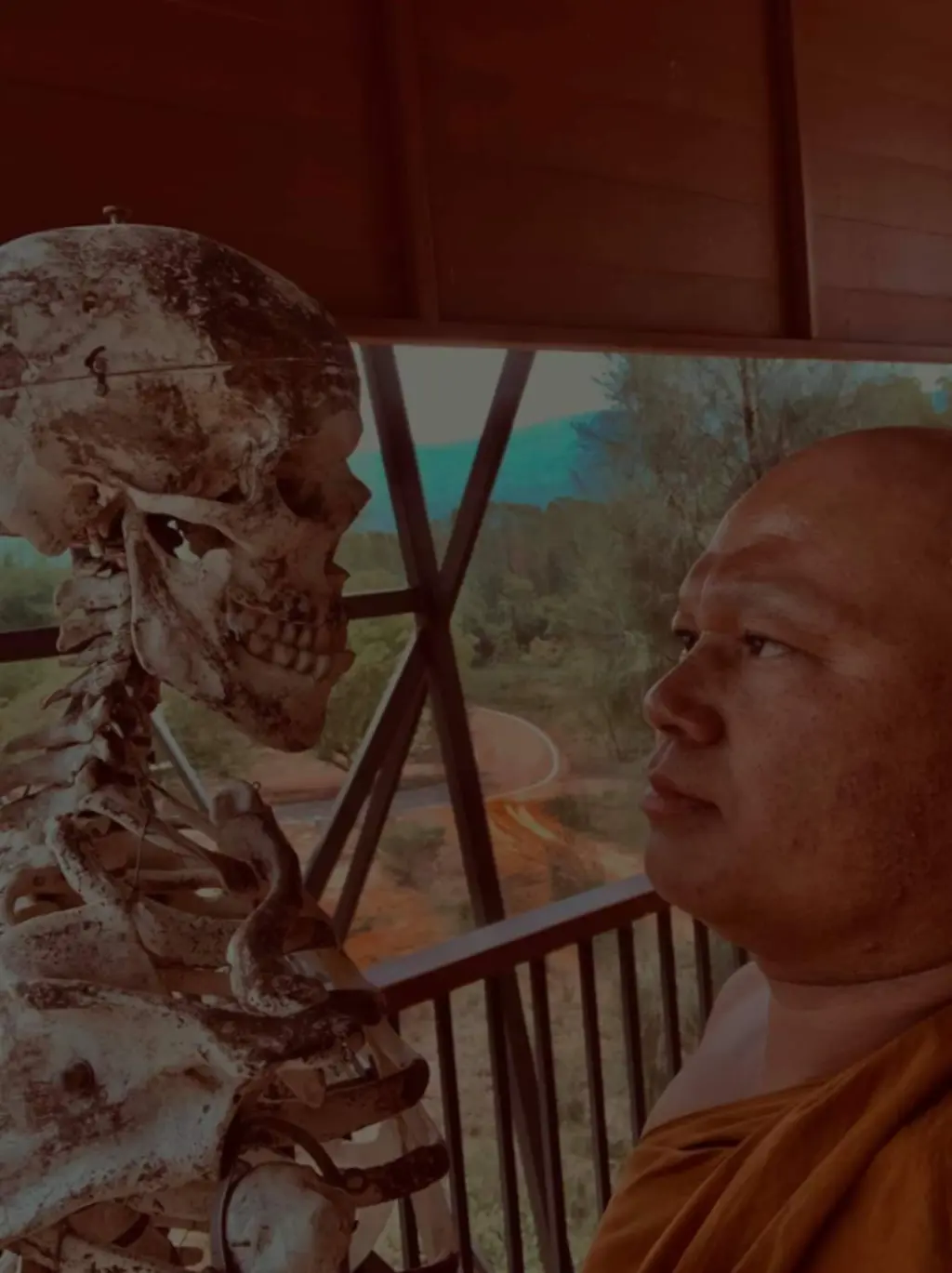Monks Goings To Autopsies

Autopsy Table found on Wikipedia. The table we saw did not have “containment walls”
Is it true that forest monks actually attend autopsies? Yes it is actually quite common. After being a monk for perhaps more than 10 years, I remember a senior monk expressing surprise when he discovered I hadn’t seen one. He said, “You haven’t been to an autopsy yet?”
“You haven’t been to an autopsy yet?”
Senior Monk
Previous Attempts:
I think it was 2011, during a previous trip to Kandy, Sri Lanka for a brief vacation from my monastery, Na-Uyana, another monk and I visited Kandy General Hospital’s morgue, curious about the possibility of viewing an autopsy. We were instructed to return the next day for information. However, when we did, we were told, “The boss doesn’t approve of that anymore,” and that was how we missed our chance.
The other potential site was the Police Mortuary in Colombo, but it didn’t sound particularly safe. An excerpt from a guide on monasteries in Sri Lanka provides some details:
Police Mortuary. St. Francis St. (Off Kinsey Rd.) It is situated in the small St Francis Street behind the Medical College (which is opposite the SE corner of the General Hospital complex.) This police morgue is suitable for precising the asubha-kammaṭṭhāna. Buddhist monks normally do not need to get official permission to enter here and they can walk in and have a look. Otherwise, ask permission from one of the anatomists or the director, Dr. Alwis. The monk at the nearby Central Hospital Vajirāmāya—see above—can help too. Laypeople need to be accompanied by a monk. There is very poor hygiene and one needs to be careful. Don’t go bare-footed into the cutting theaters as there are scalpels, blood stains, etc., on the floor. Afterward one will need to wash all one’s robes to get rid of the odor that will penetrate them very quickly. Open every day, but on Saturdays and Sundays only in the morning.
Taken from: Forest Monasteries and Meditation Centres in Sri Lanka
How It Came To Be:
Several weeks ago, Venerable Devananda taught us (academically) about the 40 different samatha (calming) meditation subjects. Interestingly, ten of these focus on the repulsiveness of the body, known as asubha. You can look it up on google or check out the elaborate Wikipedia Link. As we discussed this, I proposed that our institute arrange a visit to an autopsy. With our mid-term break approaching, it seemed like the perfect time for such a field trip. When I reminded Venerable Devananda of this idea recently, he said it would be challenging but agreed to try. Today, while walking on the road, I saw Venerable Devananda and he informed me that five monks were invited to a hospital about an hour away to view the body of a recently deceased man.
We had to move quickly and within 5 or 10 minutes we organized four other monks plus the driver. The four monks were, Ven. Nāthaputta (Nepal) Ven. Kusaladhamma (USA), Ven. Kassapa (Nepal) and Ven. ñānagavesi (SL). Everyone who was invited quickly agreed. Nobody said “no,” even though we knew that we might forgo our lunch that day due to timing. Below is a picture of us traveling in the car. We had a small snack on the way, but pretty much, in monk’s terms, we missed our meal. It was totally worth it and ehem…I was not so hungry afterwards.

Coming back from autopsy
The Hospital Morgue:
When we arrived, we could see the family waiting at the morgue. Consent forms were signed by the relatives for us to view the autopsy of a person who died suddenly at age 70. The doctors were very kind to us and asked us if we needed to wear rubber boots. Why rubber boots? I’ll leave that to your imagination. I declined and I guess I ended up speaking for the group as well. We had a chief doctor, an assistant doctor, and 2 helpers. The room was small, but it was well ventilated. The deceased man was still dressed in his cloths and wearing a jacket.
Why See An Autopsy?
Before the doctor began, he asked us what we were interested in seeing and learning. I told him that in Buddhism, we are taught to see the person as a bunch of parts. To take away the concept of a human, and to see the human as a reality. Realities go very deep on many levels, but one of the most basic levels is the body parts. The goal is to understand that that all conditioned things (life) are impermenant that death is sure to come. The goal is to see that life is suffering (that health deteriorates and we are all going to die even though we don’t want to.), and Lastly, it is a goal to see that there is no true self, that we have no control over our body’s course of deterioration and many aspects of human thought. We are also just a bunch of mind and matter that arises and passes away and appearing to group together to give the illusion of control and self. We can penetrate these 3 qualities in various ways. It is mentioned in various suttas. The most famous would be the Satipaṭṭhāna Sutta (4 foundations of mindfulness). In this sutta in mentions the 9 charnel ground meditations as well as the “32” parts of the body. So it is important to see the body as a bunch of parts, contemplating impermanence, suffering, and non-self. (anicca, dukkha anatta). We also have a long standing tradition to contemplate our own death. It is a long standing tradition of forest monks to chant mindfulness of death and mindfulness of repulsive nature of the body twice per day. We do this in the daily morning chanting at this monastery. They are often called the 4 protective meditations: buddhānussati mettā, asubha, maraṇassati
buddhānussati mettā ca
asubhaṃ maraṇassati
iti imā caturārakkhā (These are the four protections)
bhikkhu bhāveyya sīlavā. (a virtuous bhikkhu should develop)Caturārakkhā from the IIT Chanting Book
What Happened:
First they took off the cloths, and then began to rinse the body off. The arms were stiff and it was a little unnerving to see. That was the first thing that struck me. Then as other videos might show, they started from the head, and then worked their way down to the bowels. They cut the scalp and then pulled the scalp over the face. Then they took a small grinding wheel to open up the cap and inspect the brain for a cause of death. After the brain was removed, we took an educational look to see the human head with nothing inside. The doctor sliced the brain in to one inch strips and inspected it for abnormalities and saw that there was no cause of death in the brain. Then they opened up the chest by clipping the ribs with a special tool that resembled bolt cutters. “Click click click”, the ribcage was then removed. We could see everything in side. We saw the other organs one by one pulled out and laid onto the inspection table for systematic inspection. After each organ was finished, it was placed into a bag to be returned to the body for the funeral. The cause of death was a calcified blockage in his heart. If he had exercised he would have noticed something was wrong. However, it could have gone unnoticed with a relaxed life. The doctor said he would likely be a cause in the heart before we started. He died suddenly so that was the reason for the autopsy.
Some Differences Noted:
The fat was very yellow, like butter. The small intestines were not so small. The stomach is often assumed to be something very tough and big. It is just a small organic bag with partially digested food. It behaved just like a 3 Liter plastic bag filled with liquid. I got a whiff of the stomach when it was opened up and inspected. They were very careful not to make a mess while we were there. Especially with the stomach. Surprisingly there was very little blood. Perhaps it was because of the special table they had. However, most of the chest cavity is filled with parts rather than blood. If you are really interested, an autopsy video available here
Takeaway and Conclusion:
In conclusion, I deeply appreciate the experience. While I’ve watched videos and browsed through medical books, and even practiced visualizing my own body parts as every monk is tasked with doing upon their ordination, witnessing an autopsy firsthand was profoundly eye opening. If a picture speaks a thousand words, what is the worth of witnessing reality? This encounter will leave a lasting mark on me, and I’m so very grateful to all those who made it possible. The doctor’s generosity in offering another visit for a potential group tomorrow was also touching. If a suitable body is available, he said to call, even as soon as tomorrow.
Summary Poem
In the heart of Sri Lanka, where sacred monks tread,
To see life’s secrets, only known by the doctors and the dead.
Through autopsies, the body’s truths hard to embrace,
Revealing the impermanence, in life’s swift-paced race.
In Kandy, the morgue’s doors were open and then firmly closed,
Yet opportunities happen, so knowledge can be sown.
The quest for knowledge, for truths so deep and vast,
Seeking profound lessons from the old ancient past.
In Buddhist teachings, a profound truth to impart,
Focus on body parts detached, the mind and heart.
It is seen in another but within the self, not easy to see
As the lotus unfolds, the inner parts will show the reveal.
The asubha of flesh, the reality laid so bare,
Meditations on the cycle of life for monks to share.
An experience profound, with deep insights to unveil,
To disconnect the tracks and to leave the rails .

Why Do Monasteries Have Skeletons?
If you go to a Theravada Buddhist forest monastery in Asia, you are likely to find a full skeleton or parts of a skeleton somewhere where it can be viewed easily. Why?
Picture credits:
Table Wikimedia cc-SA-Atrib
Click below to search subjects